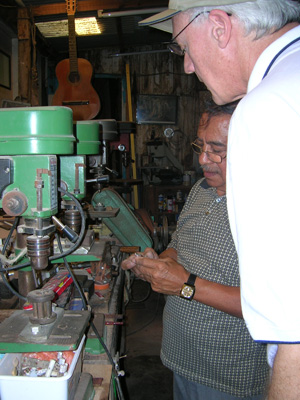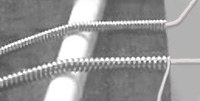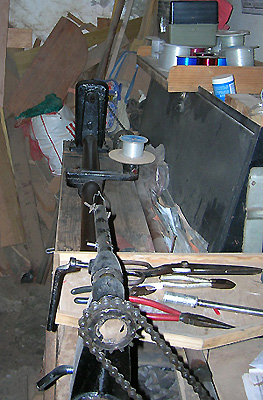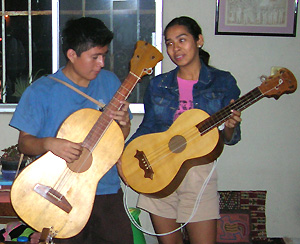
The Requinto or Guitarra de Son is the name given to the instrument that usually only has four strings and carries the melody. It is played with a variety of picking styles. Most often, the plucking style or punteado is executed with a plectrum, called espiga or pluma. This type of pick can be made of horn, bone, or plastic. Just like the Jarana, there are multiple tunings for the Requinto, the most common being (from the lowest string up) C D g c . The Requinto is made in many different sizes and the smallest is jokingly called a mosquito. The larger versions are called by various names, including leona, vozarrona, bocona or bororona. The requintas follow the same system of naming as the jaranas, from primero to cuarto (fist to fourth). At left are two four-string requintos.
Gilberto Guiterrez prefers to use the Jarana for melody lines instead of the Requinto. The Jarana, strung with pairs of strings, has a richer, more complex sound owing to the additional harmonics added by pairs of strings. (It is interesting to note that the top and bottom strings of a five course Jarana are single, like some baroque guitars. The top string of the lute was also usually single). The Requinto, especially the mosquito, can be bit strident. Traditional Jarana tuning (from the bottom up) is G CC eE aa g. Note the octave stringing on the E course. The first and last course are single, the three middle courses are double strung. The Spanish word for "course" is "ordenes." A five-course Jarnana is a "Jarana de cinco ordenes" even if the top and bottom string are single. Most Spanish speakers are unfamiliar with the word "ordenes" used in this context, just as most English speakers do not know that a pair of strings on a baroque guitar or a lute is called a "course".
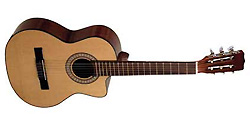 Confusion City! The term "requinto" refers to many, many different instruments in Spanish and Portuguese-speaking countries. The requinto guitar is a smaller version of the classical guitar, with six strings and a higher pitch. It is used in Mariachi bands. There are also requinto drums and other high-pitched instruments that go by this name. If you do a search on the internet for "requinto", you will come up with a miniature classical guitar with six strings and a cutaway to allow access to the higher frets on the body. The mariachi tradition is a wonderful part of Mexican folklore, but is quite separate from the Son Jarocho tradition. The playing styles and the music are remarkably dis-similar. Confusion City! The term "requinto" refers to many, many different instruments in Spanish and Portuguese-speaking countries. The requinto guitar is a smaller version of the classical guitar, with six strings and a higher pitch. It is used in Mariachi bands. There are also requinto drums and other high-pitched instruments that go by this name. If you do a search on the internet for "requinto", you will come up with a miniature classical guitar with six strings and a cutaway to allow access to the higher frets on the body. The mariachi tradition is a wonderful part of Mexican folklore, but is quite separate from the Son Jarocho tradition. The playing styles and the music are remarkably dis-similar.
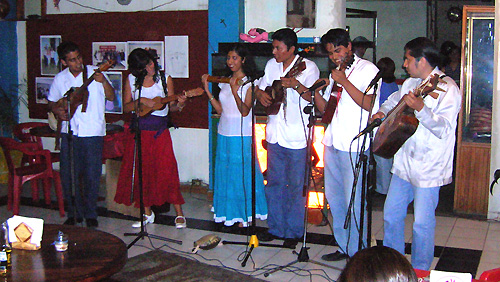
It is important to understand that the insruments are part of a living, developing tradition, and that luthiers will continue to experiment with many different styles and shapes. The group at left, Son de Son was playing in Naval a little restaurant in Xalapa that featured live Jarana bands every Saturday night. From left to right can be seen a Jarana segundo, a Requinto mosquito, a Sonajas (Rattle), two Jarana terceros, and the large bass known as a "leona" or the "Guitarron Jarocho" or the "Guitarra enter" or simply "Baja". (The naming can vary from district to district or from group to group). The big bass requinto most often has only four strings and plays a melody, or improvises on a melody.
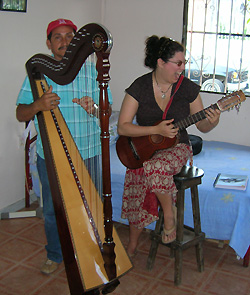
The other important instrument in the Son jaraocho tradition is the harp. Tina and I met a fantastic harpist named Guillermo Delgado Yepez and played a little music with him. Guillermo does harp presentations for the Spanish language school. The traditional harp can have 32 to 38 strings and is not carved from solid (like the harps of ancient Irelnd) but is fabricated with a very thin soundboard, sides and back. The tuning is diatonic. They rarely have sharping levers, but must be quickly re-tuned to a major or minor scale, depending on the song. The harpists typically have longer fingernails to get a loud, percussive sound from the strings. The harp functions sometimes as a solo instrument, but usually accompanies the melody with rapid, flowing improvised passages.

This Jarana band employs a harpist, two jarana players, a requinto, and an upright bass. The dancers don't just follow the music, they provide a rhythmic percussion with the hard soles of their dancing shoes that is an important part of the music. Although this couple is dancing on the floor, they normally dance on a wooden box (which can be seen behind them in the photo) called a tarima. A hole cut in the sides and front of this platform allows the amplified sound of the zapatea to fill the room. The dance is called zapatea because the word for shoe is zapato.
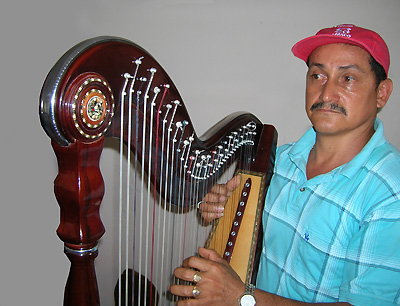 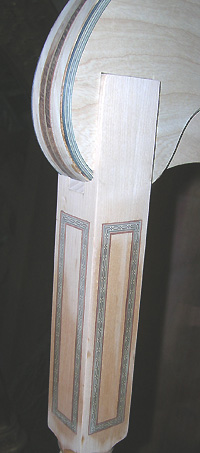 Guillermo's harps shows the exquisite workmanship of the inlay work. Notice the lack of sharping levers. At right is an unfinished harp showing inlay work with different colored woods.
Bibliography
1) 300 Acordes Pa Jarana Jarocha, by Román Méndez Saldaña. Privately published by Culturaama in Xico, Veracruz, Mexico.
2) Son Jarocho — Guía histórical-musical, by Rafael Figueroa Hernández. Este libro fue posible gracias a un apoyo del Fondo Nacional para la Cultura y las Artes, 2007. Incluye un CD-Rom con grabaciones en video, preexistentes o realizadas especialmente para el libro, de diversos aspectos del desarrollo histórico del son jarocho.
3) La Guitarra de Son, by Francisco García Ranz and Ramón Gutierrez Hernández. Cuadernas de Cultura Popular, Instituto Veracruzana de la Cultura, 2002. ISBN: 970-687-021-0. Incluye un CD-Rom con ejemplos musicales.
4) La Mona, by Juan Pascoe. Universidad Veracruzana 2003. ISBN: 968-834-619-5 A work of fiction that leads to a deeper understanding of the Son Jarocho traditions.
5) Antonio Corona Alcalde, 1995 essay 'The Popular Music from Veracruz and the Survival of Instrumental Practices of the Spanish Baroque' See especially III) GUITAR-RELATED INSTRUMENTS IN VERACRUZ pp45-50.
|
|



 Confusion City! The term "requinto" refers to many, many different instruments in Spanish and Portuguese-speaking countries. The requinto guitar is a smaller version of the classical guitar, with six strings and a higher pitch. It is used in Mariachi bands. There are also requinto drums and other high-pitched instruments that go by this name. If you do a search on the internet for "requinto", you will come up with a miniature classical guitar with six strings and a cutaway to allow access to the higher frets on the body. The mariachi tradition is a wonderful part of Mexican folklore, but is quite separate from the Son Jarocho tradition. The playing styles and the music are remarkably dis-similar.
Confusion City! The term "requinto" refers to many, many different instruments in Spanish and Portuguese-speaking countries. The requinto guitar is a smaller version of the classical guitar, with six strings and a higher pitch. It is used in Mariachi bands. There are also requinto drums and other high-pitched instruments that go by this name. If you do a search on the internet for "requinto", you will come up with a miniature classical guitar with six strings and a cutaway to allow access to the higher frets on the body. The mariachi tradition is a wonderful part of Mexican folklore, but is quite separate from the Son Jarocho tradition. The playing styles and the music are remarkably dis-similar.


